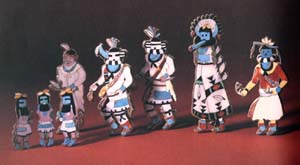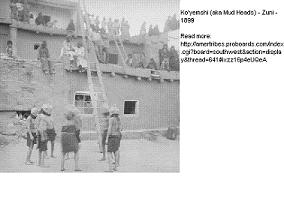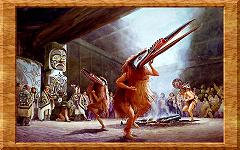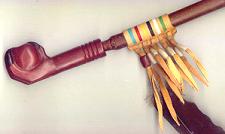CLICK ON THE SNOWFLAKE TO OPEN THE DOOR!
HAPPY HOLIDAYS FROM TEDY WARD
The Winter Spirit: America Before the Advent
Most cultures throughout the history of human society have honored the changes of the seasons. The more settled or agriculturally developed the society, the more significance the society places on the transitions, particularly the ones that signal the harvest and the planting.
There were possibly up to five hundred different Native American groups in the Americas when Columbus arrived in 1492.1 These cultures varied in structure from the complex civilizations of the Aztecs in MesoAmerica and the Incas in Peru to the more-loosely connected peoples in eastern North America such as the Hodenosaunee and the Cherokee, to the nomadic cultures of the Plains Indians, small groups who followed the migrations of the buffalo. The celebrations and rituals that honored the change of the seasons are as varied as the peoples themselves. Almost all of the native peoples revered the growth and harvest of maize, one of the staples of all Native American cultures, and most cultures honored the hunt, whether it was for buffalo or deer or salmon or turkey. Here are a few, but by no means the majority.
One of the most significant winter celebrations is the Shalako Ceremony of the Zuni Indians of modern-day New Mexico. This ceremony was originally designed to encourage the Mother of Game to have many children and to honor those creatures that the Zuni had killed during the year.2 The Shalakos are messengers of the kachinas, the spirits who bring the rain to this arid region to inspire crop growth3:
“In the World Below, where they lived for half the year, the kachinas were pure spirit. But during the six months they were on earth – from the winter to the summer solstice – they assumed material form and inhabited the bodies of the kachina impersonators. Whenever the impersonators wore their kachina masks andcostumes, these men . . . felt themselves to be the kachinas, imbued with the qualitiesof these supernatural beings . . .”4
Like most native cultures, dance was a significant part of the celebration. The Shalako Ceremony included dancers dressed as deer and other animals, who start the ceremony by running around the village, led by the Hunt Chief. The dancing lasts all day, and at the end of it, the women of the village chase the ‘deer’ from town then capture them and take them home to feed them. In return for feeding and caring for the ‘deer’, the women will eventually receive the bounty of meat. As an interesting aside, any ‘deer dancer’ who was not caught by the time the sun went down was believed to turn into a real deer.5
![]()
“Shalako Dancers by Leo Poblano”13
Another part of the kachina dancers are the koyemshi, or ‘mudheads’, the Zuni sacred clowns. Their role was to bring a level of humor to a serious ceremony, sometimes by mocking the solemn behavior of the other kachinas. Like the other kachinas, the koyemshi wear masks, but their masks are intentionally designed to be humorous.7
“Mudheads”13
The Hopi peoples, closely related to the Zuni, celebrated the midwinter solstice with the Soyal Ceremony, which marks the first time the kachina spirits came to the tribal villages. Every morning for months before the solstice, a designated sun watcher from the village sat on a rise or plateau and watched the sun rise, tracking its progress through the sky. From this, he could tell when it reached the solstice, the shortest day. From there, Hopi could predict when to plant crops for the spring.8
For the Soyal Ceremony, the kiva, the large room used for rituals, was purified and decorated, the floor covered with cornmeal mixed with herbs and other ritual plants, and then flowers were placed in specific patterns, to mirror the universe. Eagle feathers, corn ears, and other sacred items were included in the decorations. After blessings from the priests, cornmeal was taken to the home of each family of the tribe. The rituals were followed closely, in the belief that they are necessary to draw the sun back from the south. On the day of the winter solstice, which the Hopi call the Itiwanna, a new fire is lit, “to rekindle the sun’s light”.9 The villagers entered the kiva and performed a set of rituals that involve the Soyal kachina, who wears a mask with a cornhusk and painted with symbols of the sky, the world of the sun. The dance he weaves among the people was supposed to alter the path of the sun, drawing it back.10
The peoples of the northwest coast of North America, including the Chilkat, Tlingit, Kwakiutl, Quinault, Chinook and many others, also used masks as part of their winter ceremonies. The Kwakiutl dancers used masks carved to resemble ghosts, bears, wolves, ravens, whales, bees, owls – everything that was part of their natural world. Dressed in furs, feathers, and strips of cedar bark, the dancers and the dances served to remind the people of the forces that control their lives, the forests, ocean, and sky.11 For these peoples, food was abundant even in the coldest times, and the ceremonies were accompanied by feasting; salmon was especially plentiful and there were ritual ceremonies to honor the spirits of the salmon.12
“Winter Dance” by Gordon Miller13
The Iroquois of eastern North America, like many of the Plateau Indians, celebrated midwinter as a time of renewal.14 The Winter Spirit Dance could last from four to ten days15, and each day started with thanksgiving prayers and the burning of tobacco, one of the sacred plants. As part of the new year, other ceremonies were performed in the same period, including naming ceremonies for babies, healing ceremonies, and the Feast for the Dead, where food and tobacco were offered to the souls of those past to help them rest.16
Dreams were a big part of Iroquois spirituality; they believed that part of the human spirit could leave the sleeping body and experience things that were recalled in dreams.17 Often during the Midwinter Ceremonies, there were ceremonies and rituals to act out and interpret the dreams of members of the tribe, to try to determine their message.18 Dreams were considered to be ways to tell the future, particularly of illnesses, and ways to cure them. Older dreams, from previous years, were often as important as new ones.19 People who were ill asked for dances to relieve them of the spirits that plagued them, and dancers with different spirit ‘cures’ (from different secret medicine societies) would dance first for them and then in every other home in the village. Dances could go on for days, until every dream and every illness were addressed, and then on the last day of the ceremony, thanksgiving dances and chants were performed.20
Many tribes used the winter period as a time to gather with other like-minded tribes, to share stories of their travels and their year, to be social with each other for peace and prosperity. Plains Indians, such as the Sioux of the central northern area of North America, held feasts and dances, with games and prayers, and the Sacred Pipe. The pipe was special, as it was the physical representation of bond between Wakan Tanka, the Great Mystery Power21 and the earth and the people on it.22
Eagle Claw Holding Mother Earth Globe”23
The winter was a time of trial for many Native American peoples, but as with most cultures, it was a time that brought people together in celebration and friendship and peace.
Indian Culture Areas24
1. 500 Nations: An Illustrated History of North American Indians, Alvin M. Josephy, Jr. (Alfred A. Knopf and Sons, New York, New York), c. 1994.
2. World of the American Indian, National Geographic Society, Jules B. Billard, editor (National Geographic Society, Washington, D.C., c. 1989), p. 167.
3. “Systems of Knowledge” by Clara Sue Kidwell, in America in 1492: The World of the Indian Peoples Before the Arrival of Columbus, edited by Alvin M. Josephy, Jr. (Alfred A. Knopf, Inc., New York, New York, 1992), pp. 369 – 403, p. 369.
4. America’s Fascinating Indian Heritage, Reader’s Digest, James A. Maxwell, editor (Reader’s Digest Association, Pleasantville, New York, 1990).
5. Op.Cit., National Geographic Society, Jules B. Billard, editor, p. 167.
6. Website: American Masters of Stone, “Biography of Leo Poblano”, http://www.americanmastersofstone.com/Biographies/Leo%20Poblano.htm
7. Enduring Harvests, E. Narrie Kavasch (The Globe Pequot Press, Old Saybrook, Connecticut, 1995).
8. Op. Cit., Kidwell, pp. 369-370.
9. Op. Cit., Kavasch, p. 111.
10. Ibid., pp. 111-112.
11. Ibid., p. 140.
12. Ibid., p. 142.
13. Website: “KWAKIUTL CEREMONIAL DANCE MASK”, http://www.members.tripod.com/skeena50/ceremonies.html (“Winter Dance” by Gordon Miller)
14. Ibid., p. 132.
15. Plateau Indians, Craig A. Doherty and Katherine M. Doherty (Chelsea House Publications, 2008), pp. 49-50.
16. Op. Cit., Kavasch, p. 133.
17. “Religious Forms and Themes” by Sam D. Gill in America in 1492: The World of the Indian Peoples Before the Arrival of Columbus, edited by Alvin M. Josephy, Jr. (Alfred A. Knopf, Inc., New York, New York, 1992), pp. 277 – 303, p. 291.
18. Ibid., p. 292.
19. Op. Cit., Kavasch, p. 133.
20. Op. Cit., Reader’s Digest, James A. Maxwell, editor, pp. 136 – 137.
21. Ibid., p. 183.
22. Ibid., P. 184.
23. Website: “The Native American Chanupa, the Sacred Pipe”, http://www.barefootsworld.net/chanunpa.html
24. Website: “Native American Cultures”, http://www.ri.net/schools/Glocester/WGES/Rsrcpgs/NA/page22.htm
Tedy Ward is the co-author, with Margaret Mills, of two historical fiction works, Well-Traveled and “Earth and Air, Cedar and Sage”, both of which revolve around the developing relationship of a Lakota Sioux Indian, Jedediah Buffalo Bird, and his companion, Gideon Makepeace, a sharpshooter and horse trainer for Bill Tourney’s Wild West Show, as they travel across the American west of the 1890s. The works are available from Dreamspinner Press.
Advent Calendar Giveaway!
Tedy will buy one ebook from Dreamspinner for one lucky commenter. Winner to choose their book when the announcement goes up on Christmas Day.
The BONUS BUMPER PRIZE QUESTION (don’t answer this – just save them up for Christmas Eve.)
4. What was the surname of the main character (played by Jimmy Stewart) in “It’s a Wonderful Life.”?
Filed under: Advent Calendar, Tedy Ward |














Another great post. This is such a brilliant advent calendar. (Love that Winter Dance picture.)
Tedy, which is your favourite of those traditions?
Oh, it’s way too hard to pick. And there are others that I didn’t get into the mix. Of the list there, probably the ones involving tobacco; according to what I’ve read, Indian tobacco was not like the tobacco that we think of today, but was more like, well, um, marijuana. It gives the Sacred Pipe/Peace Pipe a slightly more interesting significance!
Wow lots of interesting info. I’d like to see more M/M stories set in Native American culture.
Have you read either of these titles (similar titles, but that’s all).
Two Hearts, Two Spirits by Michael Halfhill, Dreamspinner Press. I haven’t read it yet, but I know the author and I’m sure it will be a good story.
Two Spirits: A Story of Life With the Navajo by Toby Johnson & Walter L. Williams, Lethe Press. Williams, btw, is an anthropologist and expert on the Native American culture. So not only is it a very good story, you know it’s dead-on accurate. I’ve read it more than once.
Both deal with the berdache traditions. Strictly speaking, I suppose, not m/m but if you like m/m love stories, you’d enjoy it.
Thanks for the suggestions! I haven’t read those, but I certainly will!
Thanks for a great, informative article. References are a wonderful thing.
I’m especially happy that it points up the fact that there were so many tribes, with such varied customs.
I’m not Native American myself, but I’ve been doing a lot of reading on Navajo and their neighbors for a project, and every time I see an article talking about “Native American Religion” (singular) or read a novel where the author freely mixes customs of half a dozen tribes, it makes me want to throw the offending document across the room.
I have to admit that it was a challenge, reading up on the different groups and how they celebrate. Even ‘unified’ cultures had variations within tribes or smaller groups. Each tribe or even sub-group within a tribe had different rituals and concepts.
Thanks for the feedback!
Thank you for the fascinating post, Tedy. As one who can proudly claim 1/4 Choctaw blood (along with Scots, Irish, and Welsh — no immigration laws then) I’m always happy to see recognition of native customs, regardly of which tribe is written about. Too often the conquering people pretend there were no traditions prior to their own.
And thanks for reading! I have some Cherokee myself but it’s slight. It’s amazing how diverse and complex the Native American cultures are, and how little we really know, even now.
Thank you for the fascinating information. I do love to learn about other traditions. I am enjoying your advent calendar
That’s a great post Tedy! Thank you 🙂 I’ve always thought it was a shame that we treat America as though its history started with European settlement, because there’s so much before that worthy of interest and study.
I’m honored – thank you for reading! It’s one of the wonderful things about history, that every so often, we ‘reinvent it’ when someone looks at something from a different angle and gives it a new perspective. The history of the people who were here before Columbus is slowly coming to light – very slowly – and it is fascinating! I hope we see more of it, and that it also inspires more fiction!
What a great post. I learned a lot of new things about the Native Americans. Thank you for sharing such wonderful information.
Thanks for reading! I’m glad it wasn’t too boring!
Tedy –
By no means was it boring. For me it was an eye-opener insight into the original Americans. I also appreciated the resources bibliography too, which gives it its due cred.
Thank you! I”m not sure Erastes appreciates is to much as the footnotes were a pain to structure. I really appreciate the hard work that went into getting them in the post!
Your Faunalia post is *perfect* after this one! And a wonderful post!!
I love learning about how different folks celebrate the season. So fun to learn something new. 🙂
Thanks for reading! Yes, it is, isn’t it? The research for this was as much fun (um, maybe more!) than the writing!
Thanks for this post, Tedy. This was absolutely fascinating and I learned a lot. Happy holidays!
L
Happy Holidays to you, too – and thanks for reading!
What a truly fascinating post.
With the added benefit of making me want to check out your fiction.
Well done.
I’m honored! Thank *you*! I hope you like the fic!
Wow, that’s a great post, and I’ll definitely be checking out your stuff and what you recommended in the comments.
What a great post. I learned so many new things. Terrific.
Fascinating!
The half a year above and below reminds me of Persephone!
That was really interesting, Tedy. I must admit though, it sounds a hard life. I’m too lazy to chase deer – I prefer the crush of the supermarket.
What a wonderful posting, to learn more about American Indian traditions that I never read about before your post.